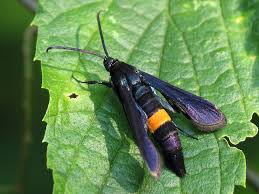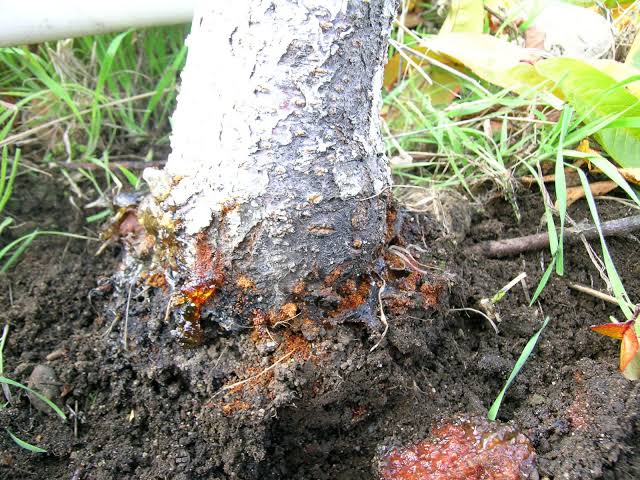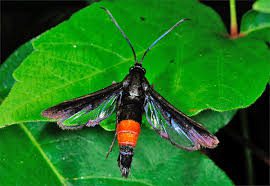The Peach Tree Borer, scientifically known as Synanthedon exitiosa, is a notorious pest that poses a significant threat to peach trees. This insect, despite its small size, can cause considerable damage to orchards, affecting the overall health and productivity of peach trees.
Peach tree borers are moths in their adult stage, and they lay their eggs at the base of peach trees during the warmer months. The larvae, upon hatching, tunnel into the bark, creating pathways within the tree’s trunk. This destructive behavior weakens the tree’s structure and disrupts the flow of water and nutrients.
As the larvae continue to burrow, the affected areas become susceptible to diseases and infections, further compromising the peach tree’s vitality. Infestations often lead to gummosis, a condition where the tree produces a sticky sap in an attempt to defend itself. Unfortunately, this defensive response is inadequate against the relentless activity of the borer larvae.
The life cycle of the Peach Tree Borer typically spans one year, during which the larvae undergo various developmental stages. Understanding this life cycle is crucial for implementing effective pest management strategies. Prevention is key in addressing this issue, and orchard owners must employ measures to safeguard their peach trees.
Cultural practices, such as proper pruning and maintaining overall tree health, can help create an environment less favorable for Peach Tree Borer infestations. Additionally, applying insecticides at the right time in the insect’s life cycle can aid in controlling their population.
Farmers and orchardists need to stay vigilant, regularly inspecting their peach trees for signs of infestation. Early detection allows for prompt intervention, minimizing the potential damage caused by these voracious borers. Timely removal of infested branches and effective insecticide application are essential components of integrated pest management.
The Peach Tree Borer, with its scientific name Synanthedon exitiosa, is a formidable adversary to peach orchards. Orchestrating a proactive approach through cultural practices and vigilant monitoring is crucial to mitigating the impact of these pests. By understanding the life cycle and behavior of the Peach Tree Borer, farmers can devise effective strategies to protect their peach trees and sustain the health of their orchards.
Read Also: How to Grow, Use and Care for Whiteedge Flatsedge Grass (Cyperus flavicomus)
Plants Affected by Peach Tree Borer

The Peach Tree Borer primarily targets trees belonging to the Prunus genus, with peach trees (Prunus persica) being its most common victim. However, it’s important to note that the Peach Tree Borer is not limited to peaches alone; it can also affect other fruit trees within the Prunus family. Some of the notable plants susceptible to infestation by the Peach Tree Borer include plum trees (Prunus domestica), apricot trees (Prunus armeniaca), cherry trees (Prunus avium and Prunus cerasus), and nectarine trees (Prunus persica var. nucipersica).
The destructive nature of the Peach Tree Borer can cause significant harm to these fruit-bearing trees, impacting their overall growth, productivity, and even survival. Orchardists and gardeners cultivating any of these Prunus species should remain vigilant for signs of infestation and implement preventive measures to protect their valuable fruit trees from the damaging effects of the Peach Tree Borer.
Beyond the Prunus genus, the Peach Tree Borer is not known to affect a broad range of plants. Its host specificity is primarily tied to the Prunus family, emphasizing the importance of understanding the insect’s preferences for effective pest management.
The lifecycle of the Peach Tree Borer involves the moth laying its eggs near the base of susceptible trees, and upon hatching, the larvae tunnel into the bark to feed and grow. This process poses a significant threat to the vascular system of the host tree, disrupting the transportation of essential nutrients and water.
In orchards where diverse fruit trees are cultivated, integrated pest management practices become crucial. Farmers and horticulturists should be aware of the susceptibility of various Prunus species to the Peach Tree Borer, ensuring that preventive measures are applied consistently across the orchard.
Regular monitoring, timely pruning, and judicious use of insecticides are key components of a comprehensive strategy to protect not only peach trees but also related fruit-bearing plants from the detrimental impact of the Peach Tree Borer. This approach promotes the overall health and sustainability of orchards, ensuring that a diverse array of fruit trees can thrive and produce bountiful harvests.
Damages Caused by Peach Tree Borer

The damages caused by the Peach Tree Borer (Synanthedon exitiosa) can have severe consequences for affected fruit trees, particularly those within the Prunus genus. The destructive activities of this pest result in various negative impacts on the host plants.
1. Weakening of Tree Structure: The larvae of the Peach Tree Borer tunnel into the trunk of the host tree, creating extensive galleries as they feed. This burrowing weakens the structural integrity of the tree, making it more susceptible to breakage during storms or harsh weather conditions.
2. Disruption of Nutrient Flow: The burrowing activity of the larvae interferes with the transport of water, nutrients, and sugars within the tree. This disruption can lead to nutrient deficiencies in various parts of the tree, affecting overall growth and development.
3. Gummosis: Infestations by the Peach Tree Borer often induce a defensive response in the tree, resulting in the production of a sticky sap known as gummosis. While this sap is an attempt by the tree to seal off wounds caused by the borer, it is often insufficient in preventing further damage.
4. Susceptibility to Diseases: The wounds created by the larvae provide entry points for pathogens, making the affected tree more vulnerable to diseases. Fungal and bacterial infections can exploit these openings, further compromising the health of the tree.
5. Reduced Fruit Production: The overall health decline caused by Peach Tree Borer infestations can lead to reduced fruit production. Weakened trees may produce smaller, lower-quality fruit or may fail to produce fruit altogether in severe cases.
6. Stress and Decline: Prolonged infestations by the Peach Tree Borer induce stress on the host tree. This stress, coupled with the cumulative damage caused by larval feeding, can contribute to the decline of the tree’s vigor and vitality.
7. Tree Mortality: In severe cases or when left unaddressed, Peach Tree Borer infestations can result in the death of the affected tree. The cumulative impact of larval feeding, coupled with secondary effects like diseases, can lead to irreversible damage and the eventual demise of the tree.
Understanding the extent of the damages caused by the Peach Tree Borer underscores the importance of implementing effective management strategies. Early detection, cultural practices, and targeted insecticide applications are key components in mitigating the negative impacts and preserving the health of fruit trees susceptible to this destructive pest.
Read Also: How To Grow, Use and Care For Threeawn Grass (Aristida Spp.)
Control and Preventive Measures

Controlling and preventing Peach Tree Borer infestations requires a comprehensive and integrated approach. Orchardists and gardeners can employ a combination of cultural practices, biological controls, and chemical interventions to manage this destructive pest effectively.
1. Clean and Prune: Regularly inspect and prune fruit trees during the dormant season to remove and destroy any egg masses, larvae, or affected wood. Proper sanitation helps reduce the presence of overwintering larvae and minimizes the risk of infestations.
2. Trunk Wraps: Wrapping the trunks of young fruit trees with burlap or specialized tree wraps can act as a physical barrier, preventing adult moths from laying eggs near the base. This simple measure disrupts the initial stages of the Peach Tree Borer’s life cycle.
3. Beneficial Nematodes: Introduce beneficial nematodes to the soil around the base of affected trees. These microscopic organisms prey on borer larvae, providing a natural and environmentally friendly form of control.
4. Insect-Parasitic Wasps: Encourage the presence of natural predators, such as parasitic wasps, which target borer larvae. These wasps can help keep the population of Peach Tree Borers in check.
5. Proper Watering and Fertilization: Maintain optimal tree health through proper watering and fertilization. Healthy trees are more resilient to pest attacks and can better withstand the stresses caused by Peach Tree Borer infestations.
6. Pheromone Traps: Deploy pheromone traps to monitor the presence of adult moths. These traps can help in determining the timing of insecticide applications and provide early warning signs of potential infestations.
7. Biological Insecticides: Consider using biological insecticides containing Bacillus thuringiensis (Bt) or beneficial nematodes. These products target the larvae of the Peach Tree Borer while minimizing the impact on beneficial insects and the environment.
8. Chemical Insecticides: If infestations are severe, targeted applications of chemical insecticides may be necessary. Apply insecticides with active ingredients like bifenthrin or permethrin according to the recommended timing and dosage. Ensure adherence to safety guidelines and regulations.
9. Rotate Insecticides: Rotate the use of insecticides with different modes of action to prevent the development of resistance in Peach Tree Borer populations. This helps maintain the effectiveness of control measures over time.
10. Early Detection and Monitoring: Regularly monitor trees for signs of infestation, including gummosis, entry holes, or sawdust-like frass. Early detection allows for prompt action, reducing the overall impact of the Peach Tree Borer on the orchard.
Implementing a combination of these control and preventive measures is crucial for managing Peach Tree Borer infestations effectively. Integrated pest management, with a focus on promoting tree health and employing a variety of tactics, offers a sustainable and environmentally responsible approach to mitigating the impact of this destructive pest.
Frequently Asked Questions (FAQs) About Peach Tree Borer (Synanthedon exitiosa)
Q1: What is the scientific name of the Peach Tree Borer?
A: The Peach Tree Borer is scientifically known as Synanthedon exitiosa.
Q2: Which trees are affected by the Peach Tree Borer?
A: The primary targets of the Peach Tree Borer are trees within the Prunus genus, including peach, plum, apricot, cherry, and nectarine trees.
Q3: How can I identify Peach Tree Borer infestations on my trees?
A: Look for gummosis (sticky sap), entry holes near the base of the tree, sawdust-like frass, and wilting branches. Regularly inspecting the trunk can reveal the presence of larvae.
Q4: When is the best time to apply insecticides for Peach Tree Borer control?
A: Insecticides should be applied during the moth’s egg-laying period, typically in late spring to early summer. Pheromone traps can help determine the optimal timing for treatment.
Q5: Are there natural predators that can help control Peach Tree Borers?
A: Yes, beneficial nematodes and certain parasitic wasps are natural predators that can help control Peach Tree Borer larvae.
Q6: Can I prevent Peach Tree Borer infestations through cultural practices?
A: Yes, maintaining proper tree health through pruning, sanitation, and avoiding stressors can contribute to preventing infestations.
Q7: What are the signs of a severe Peach Tree Borer infestation?
A: Severe infestations may lead to wilting branches, reduced fruit production, and visible damage to the trunk. Gummosis and entry holes may also be more pronounced.
Q8: How do I control Peach Tree Borers without using chemical insecticides?
A: Cultural practices, trunk wraps, beneficial nematodes, and biological insecticides are alternative methods for controlling Peach Tree Borers without relying solely on chemical treatments.
Q9: Can Peach Tree Borers kill a tree?
A: Yes, severe and untreated infestations can weaken a tree to the point of mortality. The cumulative damage from larval feeding and associated stresses may lead to the death of the tree.
Q10: What should I do if I suspect a Peach Tree Borer infestation in my orchard?
A: Act promptly by inspecting trees for signs of infestation, implementing control measures, and, if necessary, consulting with local agricultural extension services or experts for guidance. Early intervention is key to minimizing damage.
Read Also: Basic Importance of Advertising
